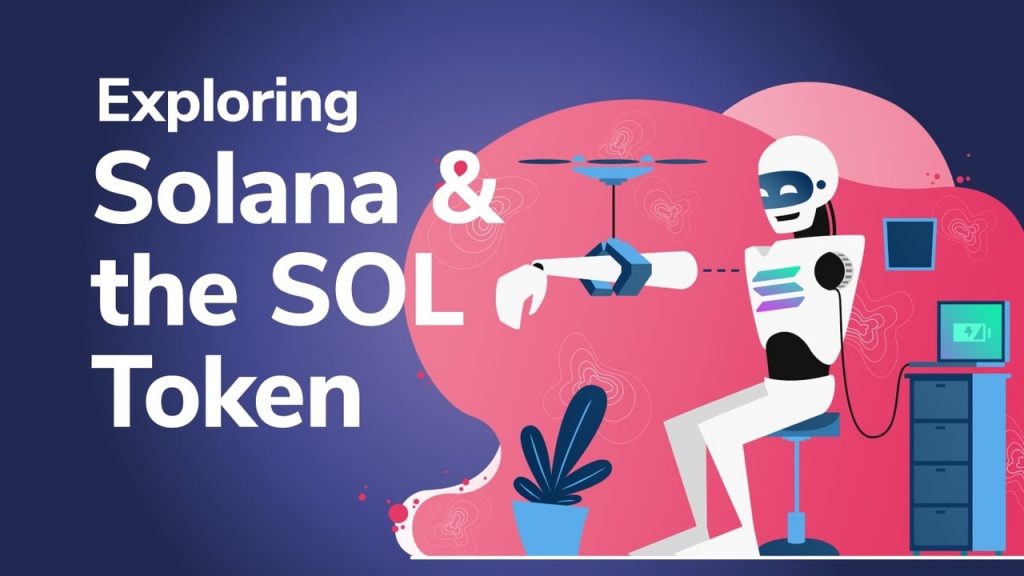
Solana has been among the top-performing cryptocurrencies since the turn of the year, with Solana’s SOL token slowly creeping up the crypto market cap ranks. Perhaps most notably, Solana brands itself the fastest blockchain in the world. This comes from the fact that the Solana blockchain produces a block every 400 milliseconds, something made possible even without the use of sharding. The Solana token has been mentioned frequently across several crypto mediums, outlets, and influencers recently. But what does the Solana blockchain do? And why has the Solana token seen so much recent success?
This article will take a close look at the Solana ecosystem and explore the fundamental aspects that give this project so much potential. Moreover, we’ll look at the SOL token casesand the roles it plays in the growing adoption and success of the Solana blockchain.
If you are new to crypto, welcome! To learn the safest ways to invest and store your cryptocurrency, please see Ivan on Tech Academy’s Crypto Basics course! Here you’ll learn how to create an exchange account, store your coins in cold wallets, plus tips to avoid being scammed. Also, whilst you’re in the Academy, make sure to see our Ethereum 101 course to gain a foundational knowledge of decentralized finance (DeFi). Ivan on Tech Academy provides educational materials across various mediums, plus a chance to interact with other students!
What is Solana Blockchain?
Created by Solana Labs, Solana is a unique blockchain designed for scaling with global adoption in mind. The Solana whitepaper was published in November 2017, with the blockchain launching its Mainnet Beta in March 2020. In April 2020, Solana Foundation was created. Solana Foundation now owns all intellectual property previously owned by Solana Labs as of this date. During the process, 167 million SOL tokens were transferred from Solana Labs to Solana Foundation, to help “advance the adoption of decentralized technologies as a public good”. A small number of SOL tokens remain dedicated to Solana Labs for funding operations.
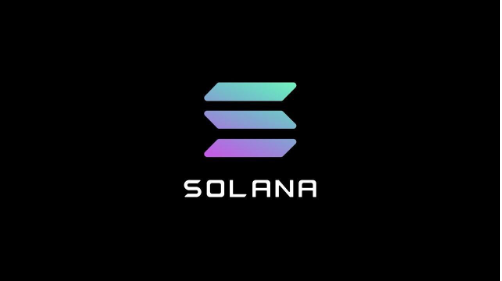
The Solana blockchain is the fastest blockchain in the world, processing 50,000 transactions per second (TPS). This is achieved by combining novel protocols interacting and transacting in a complimentary style (explained later). Solana prides itself on its ability to be unbeaten in terms of facilitating the highest transaction volumes.
Solana Foundation is based in Geneva, Switzerland. The project has a team with previous technical experience from software giants like Apple, Intel, Google, Twitter, and Microsoft. Moreover, Solana has been backed by several large and successful investors, including Foundation Capital, Abstract Ventures, and Multicoin Capital to name a few.
Solana has created a blockchain that is fast, scalable, and secure. Furthermore, this is made possible without the need for any layer 2 solutions. Also, Solana blockchain is smart contract compatible, meaning developers can build decentralized applications (dApps) on Solana.
Solana has built a decentralized clock into its own blockchain. Before this, no other blockchain could time-stamp transactions. Solana’s creator Anatoly Yakovenko achieved this by making adjustments to the SHA256 mining algorithm used by Bitcoin. Combined with an optimized Proof-of-Stake (PoS) consensus mechanism, Solana makes it possible to process a huge amount of transactions and maintain robust network security.
Solana Token (SOL)
The native SOL token is used for paying transaction fees on the Solana network. During this process, Solana tokens are burned with each transaction. Additionally, Solana token holders can stake their SOL to become a validator node (more explained below). Both of these utilities reduce circulating supply, increasing positive price pressure. Validators receive block rewards in SOL tokens, and any SOL tokens deducted from bad actors on the network are added to the block rewards pool.
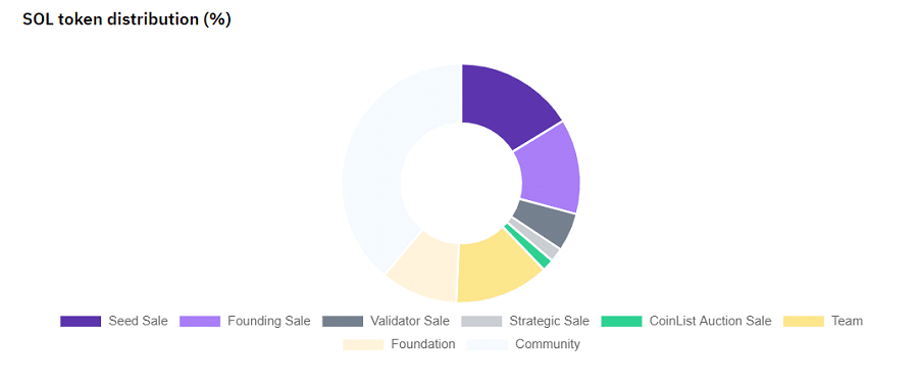
The CoinList initial coin offering (ICO) offered investors guaranteed staking rewards on their SOL tokens after the public token sale, once the mainnet is live. As Solana is still in Mainnet Beta, rewards have yet to be distributed. Prior to the ICO listing, Solana Foundation had already received over $29 million from four previous funding rounds since March 2018. Solana managed to sell over 32% of the SOL supply to private investors before the CoinList ICO. The CoinList Auction Sale sold 13% of the total SOL supply available. Furthermore, 39% of the Solana token supply is dedicated to community incentives and activities.
The Solana token has a max supply of just over 488 million SOL. The current circulating supply of SOL tokens is just over half of that at around 263 million. In 2020, the SOL token value rose three-fold from around $0.50 in May, closing the year at around $1.50. However, since the beginning of 2021, Solana has achieved a further three-fold increase in value reaching a new all-time high of $9.91 in February. At the time of writing, the price currently sits at around $9.09.
Validator Nodes
The Solana blockchain’s native SOL token powers the Solana ecosystem and secures the Solana network. This is achieved through staking SOL tokens to become a validator. Solana validator nodes are responsible for all the roles on the Solana blockchain. This includes verifying transactions, storing transaction records, and creating new blocks.
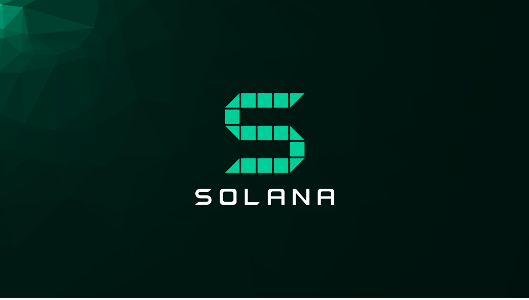
Validators lock up a chosen amount of SOL tokens and verify and process transactions on the network. In turn, validators are rewarded in fees. Additionally, users can earn validator fees by managing delegated staked tokens on others’ behalf. This means that users can be rewarded for staking their SOL tokens, without actually becoming validator nodes.
Validator nodes rotate the role of the ‘leader’ who generates blocks on the Solana blockchain. Each validator can process four blocks before the role of the leader is taken over by the next validator. This process lasts for approximately 1.6 seconds. The chance of a validator node becoming a leader is proportional to the amount of SOL tokens they have staked. The more SOL a validator stakes, the more likely they will become the leader. This makes it difficult for bad actors to attack the network and incentivizes good behavior by slashing a validator’s stake if they misbehave.
Solana offers a very low entry barrier, with no minimum SOL token requirement for becoming a validator. Also, the Solana protocol is open-source and permissionless, meaning theoretically, anyone can become a node. However, this varies between geographies and local regulatory restrictions. Moreover, to be able to receive rewards as a validator on the Solana network, users will need to complete registration and KYC (know your customer) details.
What Makes the Solana Blockchain Different?
Solana aims to solve the ‘trilemma’ of security, scalability, and decentralization for businesses to scale with blockchain technology. The project has devised eight innovative protocols, each working seamlessly to offer a solution to the aforementioned ‘trilemma’. Below we have broken down each of these novel factors that make the Solana blockchain the fastest, most secure, decentralized web-scale blockchain within the industry.
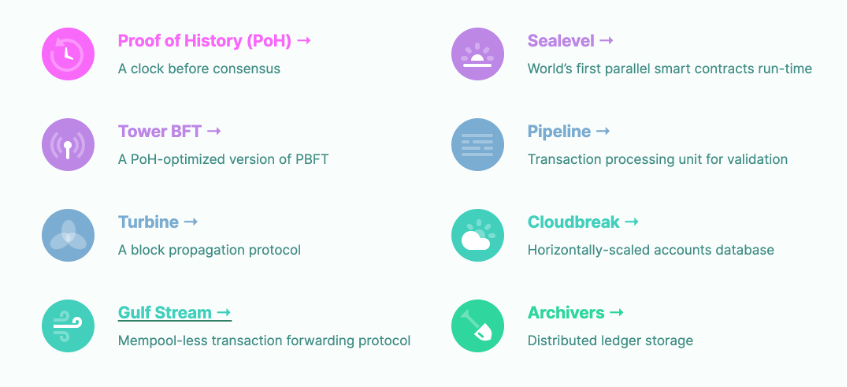
Archivers
The first novel protocol is known as Archivers. This is Solana’s solution for blockchain data storage. The average annual amount of data collected on the Solana blockchain adds up to approximately 4 petabytes of data (1gb/s * 365 days). As such, Solana needed an innovative way to store such amounts of data. This distributed ledger store was created as Solana’s take on Filecoin’s Proof-of-Replication model. However, the model has been updated to reduce vulnerabilities and is optimized for batch verification.
Cloudbreak
To achieve network scalability without sharding, Solana uses Cloudbreak as a horizontal scaling solution. Solana’s design principle is to create software that reduces the utilization dependency of hardware. Moreover, Cloudbreak is a data structure that concurrently reads and writes transaction input from across the network.
Gulf Stream
Another key element to Solana’s success is Gulf Stream. Gulf Stream is an innovative transaction forwarding protocol that facilitates mempool-less transactions. Gulf Stream is the backbone of Solana enabling a throughput of over 50,000 transactions per second (TPS). The protocol facilitates the action of pushing transaction caching and forwarding to the edge of the network, allowing validators to confirm transactions ahead of time before the next block has been finalized - reducing confirmation times and allowing substantial transaction volume.
If you want to learn more about how mempools work, check out the Blockchain and Bitcoin 101 course at Ivan on Tech Academy. This course is designed to give you a foundational knowledge of how blockchains work under-the-hood!
Pipelining
Pipelining was introduced as a transaction processing unit for validation optimization, another defining protocol to Solana’s successful blockchain model. Solana assigns different hardwares the responsibility of a stream of input data, which is essentially a set of blocks that contain transaction information that can be quickly validated and replicated across the network.

Proof-of-History
The Proof-of-History protocol is what brought the Solana blockchain into the light as the project’s breakthrough innovation. Solana uses a verifiable delay function in conjunction with the SHA256 Bitcoin mining algorithm which allows all transactions on the Solana blockchain to be time-stamped. This means that validator nodes can organize transaction records without the need for other validator nodes to confirm transaction records.
Sealevel
Sealevel is a transaction processing engine in place to obtain a more efficient runtime with the parallel processing of smart contracts. Using creative horizontal scaling solutions, thousands of smart contracts can operate in parallel to one another. Moreover, smart contracts that are in the same state on the blockchain, will also be processed concurrently.

Tower BFT
Tower BFT is Solana’s high-performance iteration of the PBFT (Practical Byzantine Fault Toleration) consensus algorithm which is optimized by Proof-of-History (PoH). The consensus mechanism uses PoH to achieve consensus across the network without any potential transaction latency through a massive messaging overhead.
Turbine
High-performance blockchains propagate huge amounts of data, which is distributed to a multitude of peers across the network. Often, such blockchains’ bandwidth requirement is too low to facilitate high-volumes of transactions between thousands of nodes.
Solana remedies this with Turbine, a block propagation protocol. Turbine works much like BitTorrent, a decentralized communication protocol that facilitates peer-to-peer file sharing across the internet. However, Turbine has some key technical distinctions. Optimized for streaming, Turbine uses UDP (User Datagram Protocol), a loss-tolerating and low-latency protocol for connecting applications online, for transmitting data. This enables faster transmissions of data before the receiving party agrees to the transmission.
This works by breaking down blocks into ‘packets’, which are then distributed to validators. Validators then retransmit packets to a group of peers known as a ‘neighborhood’. The network works as a tree of neighborhoods. Every neighborhood is required to transmit a portion of data to the neighborhood beneath it. This process allows for higher performance and lays the foundations for mass scalability.
Solana Clusters
Solana’s valued ‘Solana clusters’ are dedicated groups of computer networks committed to serving client transactions and maintaining the Solana ledger’s integrity. Several Solana clusters co-exist and are utilized whenever users want to preserve certain events or records on the blockchain, or go back and trace previous activity on-chain.

Solana currently maintains three different clusters for different purposes. The Devnet cluster is for anyone who would like to use Solana blockchain as a playground for building decentralized applications (dApps) or familiarize themselves with the process of becoming a validator node. Devnet tokens are not real, but the users can access a token faucet for application testing and familiarizing themselves with the platform.
The Testnet cluster is the next stage, where clusters stress test applications focusing on stability, network performance, and behavior of validators. Tokens issued on the testnet are also not real. However, early SOL token holders and launch partners can get access to Solana’s Mainnet Beta. Tokens issued on the Mainnet are genuine SOL with real token value. Solana is currently rewarding users for testing their Mainnet Beta, however, currently, rewards and inflation are disabled.
The SOLAR Bridge
The Solana blockchain produces blocks approximately every 400 milliseconds. Since its launch in March 2020, Solana has produced over 50 million blocks. That’s more blocks than Ethereum, Bitcoin, Polkadot, Algorand, and Cosmos combined - twice over! The SOLAR Bridge is a new innovative feature designed, funded, and constructed by Bering Waters as a commitment to the Solana and Arweave blockchains. Bering Waters is an investor in blockchains and recently formed Bering Waters Tech to build bridging functions for blockchains to scale with interoperability with future adoption.
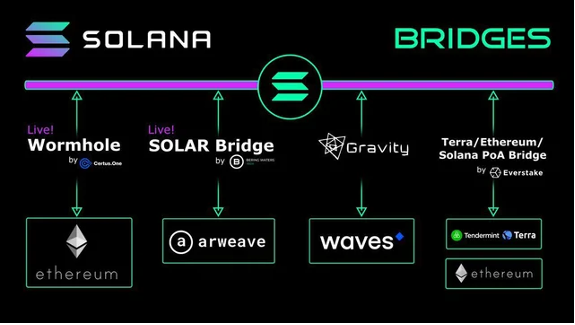
The SOLAR Bridge has been implemented to help the Solana blockchain maintain and expand its transaction capacity and cater to the needs of global financial networks. Although Solana currently facilitates 80 million transactions a day, it has the capacity to facilitate five times this much. All of these transactions add up to a substantial amount of data, which is where Arweave comes in.
Arweave is a dedicated storage network for Solana, allowing data to be stored permanently, immutably, and reliably. Moreover, Arweave’s unique approach means users pay a one-time transaction fee for data storage, with users being rewarded for storing and recalling data over longer periods. Arweave uses innovative blockchain-based solutions to bring a new dynamic to data storage.
As such, the SOLAR Bridge was introduced by Bering Waters. Ewelina Leszczak, CEO and Founder of Bering Waters Tech stated: “Arweave and Solana are two technologies disrupting at the same time, and we saw the opportunity to make them interoperable”.
Why Use Solana Blockchain?
Solana is the fastest blockchain currently on the market processing transactions in sub-seconds. Additionally, using the Solana blockchain costs considerably less than many other competing blockchains. Solana’s average transaction cost is just $0.00001!

The Solana Foundation has a dedicated research and development arm of the Solana ecosystem. This provides grant programs, education, and facilitates collaborations with third parties for continuous growth. Moreover, Solana Collective provides community and marketing incentives for Solana enthusiasts to spread the word and earn rewards!
Solana is so sure of its technology, there is a dedicated section for those looking to ‘Break Solana’. This website is a game for users to send as many transactions as possible in an attempt to Break Solana. No one has won yet!
Tour de SOL
The community incentivized testnet ‘Tour de SOL’ rewards users for things such as successfully attacking the network or being the SOL validator for the longest period. Moreover, enthusiastic and proactive Solana supporters can also be in with a chance of winning a large bag of Solana.
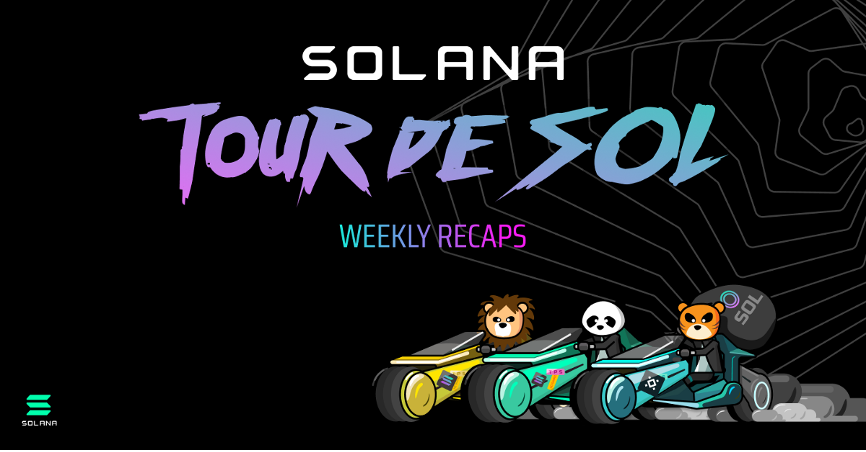
The competition is divided into three categories, with different prizes available for each one. Firstly, ‘Attacks’ is focused on developers trying to hack the network and shining light on any loopholes or bugs in the code. The first prize is a generous 31,500 SOL (worth approximately $290,000 at the time of writing).
Community supporters who are not programmers, but are still actively involved in the validator community, could be up for the ‘Team Player’ prize. A team player is defined as “an organization or individual that has been proactively helpful to other validators during the event”. This could be something along the lines of being the first to answer questions in Telegram or Discord groups. The first-place prize for this category is 3,200 SOL.
The third and final category is for ‘Community Content’. Solana is offering a first-place prize of 6,250 SOL, to anyone who produces and shares content about Solana. Solana has stated they are not looking for a ‘Solana shill’, or anything that is simply a promotion of the project. Rather, Solana is looking for quality informative and educational material that could be as simple as writing a blog post.
Solana Blockchain & SOL Token Summary
Solana is a thriving blockchain and community which looks set to continue to grow and gain adoption. Through a combination of the eight critical points of development mentioned in this article, it’s difficult to see other blockchains competing with such vast transaction volumes. The Solana team prides themselves on their blockchain performance. In the future, we can expect to see further expansion and partnerships as the value proposition of Solana becomes more widely recognized.
You can find all network activity statistics linked from Solana’s website at Solanabeach.io. Here, you can see how many network validators are in operation including their geographic location. Plus you can view how many Solana tokens are currently staked and in circulating supply.
Solana has introduced a novel consensus algorithm solving a lot of issues around speed, data storage, and scaling without compromising on security. Solana is paving the way for a blockchain infrastructure capable of global adoption and heavy throughput.
Blockchain is one of the fastest-growing industries, combining technology and finance at the forefront of a new economic paradigm. However, this industry is still young and the demand for blockchain developers is growing every day. Believe it or not, blockchain developers are highly sought after!
If you want to go full-time crypto and become a blockchain developer, Ivan on Tech Academy is the perfect place to start! Regardless of previous experience, we have courses that teach you everything you need to know about blockchain technology. If you want to become a blockchain developer, be sure to check out the Javascript Programming For Blockchain, Ethereum Smart Contract Programming, and C++ courses at Ivan on Tech Academy! Also, follow us on Twitter @Academy_IOT to let us know what you think about the Solana token!





